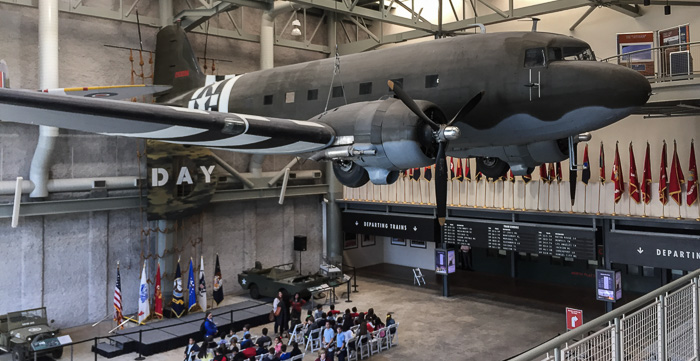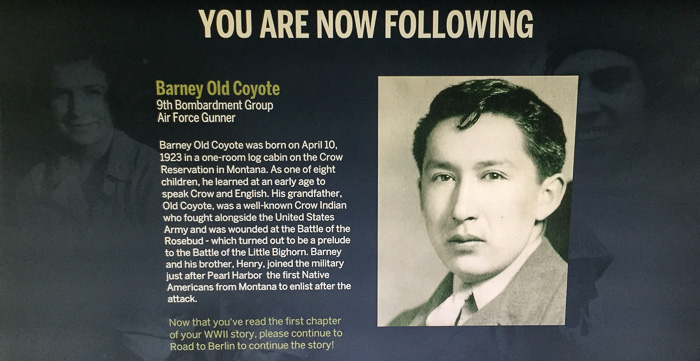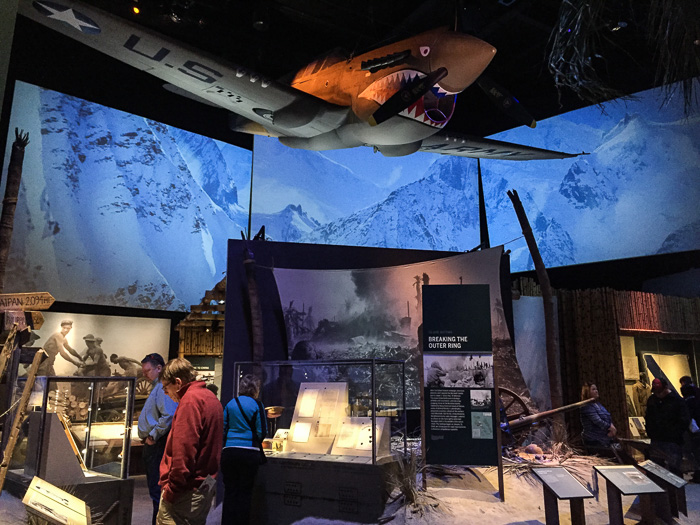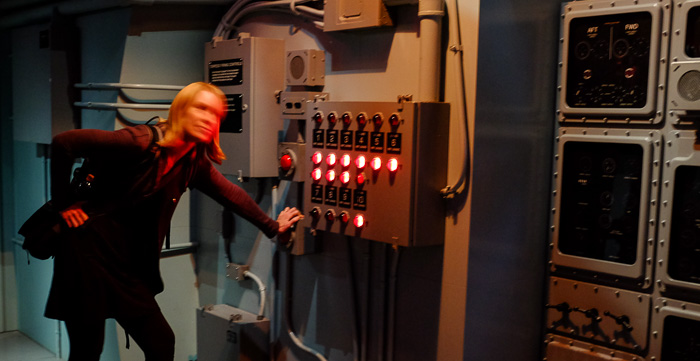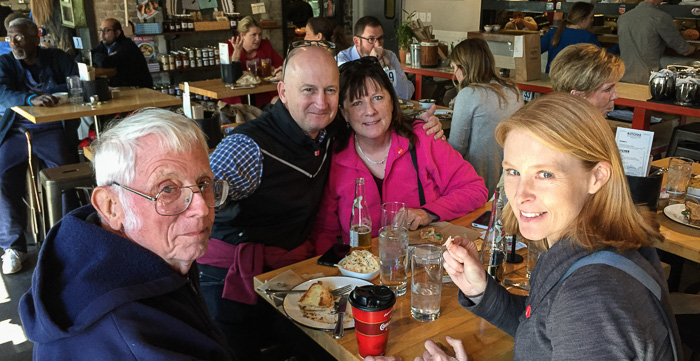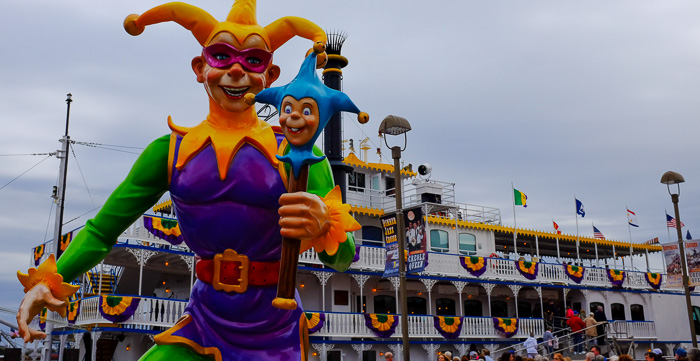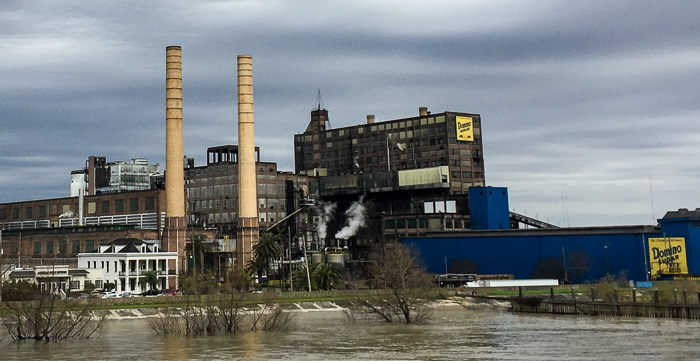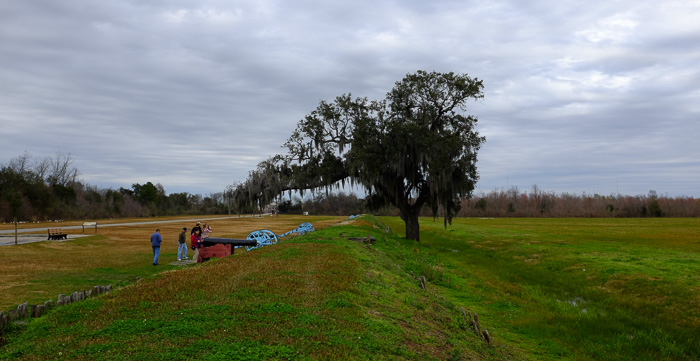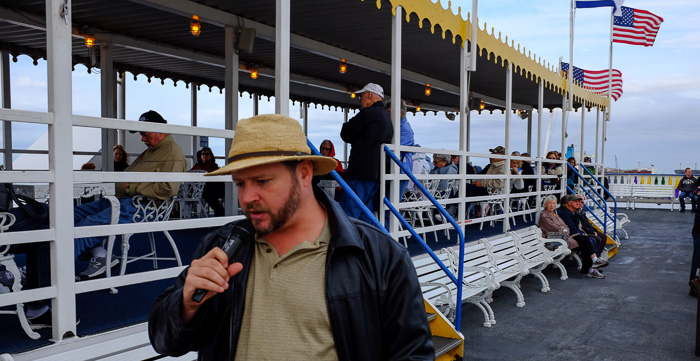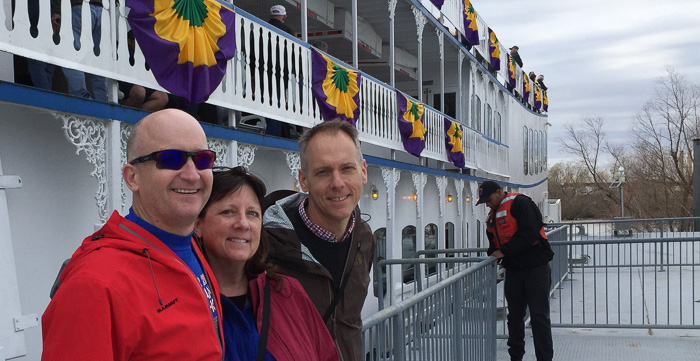New Orleans: The National WWII Museum, Chalmette Battlefield, and the Creole Queen
New Orleans offers plenty of sightseeing for military history buffs and we hit two of the biggies during our recent trip. While I knew the National WWII Museum would be a slam-dunk winner, I was pleasantly surprised by the top-notch experience at Chalmette Battlefield. We traveled to Chalmette by way of the Creole Queen paddlewheeler, so my battlefield musings are tucked within the larger cruise narrative.
National WWII Museum
Visiting the National WWII Museum was a non-negotiable priority for our group. Although our New Orleans sightseeing itinerary overfloweth, we still devoted an entire day to the museum and fully expected a fantastic experience. It’s not often that I go in with high expectations and have them exceeded. Wow! If I lived in New Orleans, I’d purchase an annual membership. Even though we opened and closed the place and took one brief lunch break, I somehow missed the Restoration Pavilion (they’re working on a PT boat!) and most of the Louisiana Pavilion. I’ll be back.
What’s so special? This isn’t just a museum, it’s an experience. Really. It starts right off the bat when you purchase admission, receive your dog tag, and board the train. The tag isn’t a real dog tag but better, like a small credit card to carry and use to collect information and images throughout the museum. And the train isn’t a real train of course, but a close approximation complete with subtle rumbling to simulate the hypnotic movement of a train in motion.
During the “train ride” I was (virtually) introduced to one WWII participant, Barney Old Coyote, a Crow Indian from Montana who enlisted at 17 and became an aerial gunner. As I made my way through the museum, I gradually stepped through Barney’s war experience learning of the letter his mother wrote to ensure he and his brother would be allowed to serve together (although against Army policy), his early training with Clark Gable who joined at the same time (!), and how he and his brother gained significant advantage for their missions by speaking Crow to each other in-flight, relaying critical information between waves of bombers. Barney is just one of many WWII participants in the Dog Tag Experience.
This aspect, the personal history and stories, is what I love most about the WWII museum. Aside from the Dog Tag Experience, there are oral history stations peppered through the museum complex. These recorded individual stories coupled with reels and reels of movie footage, strike a personal chord that rings deep. A few other notes:
- Beyond All Boundaries: We caught the first showing of this “4D experience” produced by Tom Hanks. The show lasts 50 minutes including the pre-show introduction, and in that time moved through the major events of WWII in a documentary format amped up with props, “loud noises, flashing lights, fog effects and sudden chair movements”. It’s an experience all right, and one that I enjoyed immensely, but it was powerful, moving through the war quickly leaving little time to process each hugely impactful event. Most folks were fine, but there were a few like me who couldn’t hold back tears and needed a few minutes to regroup after.
- 360-degree displays: Before visiting, I couldn’t grasp the meaning of “360-degree displays that let visitors walk through key settings”, but now…. Well if oral histories are my favorite part of the museum, these are a close second. The museum’s informational displays are like subtle movie sets. At the Battle of Midway, I stepped onto an aircraft carrier with grey metal floors and bulkheads; I met a forest blanketed in snow during the Battle of the Bulge; the Pacific theater was a tropical forest complete with palm trees and sandbags. Extremely well done.
- USS Tang Submarine Experience: This was a last-minute whim. I’m glad we did it since it relays yet another interesting story from the war, but it seems geared towards kids and teens. The experience is very interactive, allowing you to be hands-on, man a station, and work inside the sub during a battle. Fun, but not for the very young or kids who scare easily since there’s a moment near the end where the sub is “hit” and the lights go out, then flicker while you “sink”. Still many will have a ball. It’s hard to choose a station to man - I wanted to do them all!
My only negative concerns the overall noise level; I had the same issue in the Gettysburg museum. It’s a personal thing of course, but I find it difficult to concentrate and read text with multiple movies playing nearby. I make do by plugging my ears and looking silly.
One final note: We ate lunch at the Cochon Butcher sandwich counter a couple blocks away, a 5-minute walk at most. They have delicious smoked meats and outstanding muffaletta. Sidewalks are in terrible condition in a few places so watch your step. We made it most of the way with a wheelchair, but Mike walked one particularly bad spot.
Website: nationalww2museum.org
Location: 945 Magazine St, New Orleans, LA 70130
Hours: 9am–5pm daily; closed on Mardi Gras
Cost: $24/adult; additional cost for movies ($5 each) and 2nd day pass ($6)
Creole Queen Historical River Cruise
My expectations must have been dialed down for the Creole Queen River Cruise and I’m not sure why. Perhaps I’d made prior boating excursions on tired vessels since that’s what I anticipated, though I didn’t realize it until I stepped on board and found myself very pleasantly surprised. The Creole Queen is a lovely ship that’s clean and tidy, has fresh decor, and friendly and helpful staff.
We boarded at 1:30 for a 2pm departure and returned by 4:30. The three hours passed quickly, mostly due to our narrator/historian Charles. There’s not much to see on this stretch of the Mississippi but Charles kept up a running commentary about New Orleans history while also pointing out a few interesting sights along the way downriver, including two quick-deploy Navy ships, the Louisiana National Guard’s Jackson Barracks, and the Domino sugar factory.
We disembarked at the Chalmette Battlefield at 2:35pm, and were given 45 minutes to explore. That wasn’t enough time to listen to the ranger-led battlefield talk and visit the museum, so we politely bypassed the ranger and walked straight to the Chalmette Battlefield and National Cemetery Visitor Center. Excellent choice!
The new museum (rebuilt after Katrina and opened in 2011) has outstanding displays and movies that walk through the 1815 Battle of New Orleans, the last great battle of the War of 1812. The British marched against New Orleans on January 8th 1815, expecting inexperienced American troops; indeed Andrew Jackson’s forces were shored up with an impressive array of local militia comprised of free men of color, Irish immigrants, Chocktaw Indians, and French Creole elite. In the end though “…British superiority in numbers could not overcome a series of bad decisions and a run of bad luck”. Two that stood out to me: 1) when British soldiers lost their officers and had no orders to either advance or retreat, they simply stood in place and were shot down; and 2) a British unit failed to get ladders and equipment in place leaving the main column trapped with no way to scale the American defensive rampart. Brutal. The British had over 2,000 casualties; Jackson less than 100.
You can’t help but notice the Chalmette Monument, a 100-foot obelisk honoring troops in the Battle of New Orleans, but did you know you can climb it? Located just outside the museum, the monument is open Fridays and Saturdays and visitors are welcome to climb the 122 steps for a bird’s-eye view of the battlefield and surrounding area. We visited on a Wednesday, so no climbing joy for Julie :(. I’m glad I was clueless at the time - I likely would have pouted and stared longingly for the duration!
On our return trip aboard the Creole Queen, Charles recounted a summary of the battle and then segued into a stirring narrative of the days leading up to Hurricane Katrina and the misery that followed. I know it was just one person's perspective on the tragedy, but I was interested in his telling and grateful for the account.
We thoroughly enjoyed our time on the mighty Mississippi. If you go, Charles spoke mostly of sights on the east bank (French Quarter side) of the river, so sit on the port side for the outbound trip, and starboard side on the return.
Creole Queen
Website: creolequeen.com
Location: 1 Poydras St, New Orleans, LA 70130
Hours: Historic cruises daily at 9:30am and 1:30pm
Cost: $28/adult
Duration: 3 hours including boarding time and Chalmette Battlefield excursion.
Chalmette Battlefield
Website: nps.gov/jela/chalmette-battlefield
Location: [8606 W St Bernard Hwy, Chalmette, LA 70043](8606 West St. Bernard Highway, Chalmette)
Hours: 9am–4pm Tuesday-Saturday; closed Sunday, Monday and on Mardi Gras. The Chalmette Monument is open 9am–3:30pm Friday and Saturday only.
Cost: Free
This post is part of a Trip Summary: New Orleans Mardi Gras
